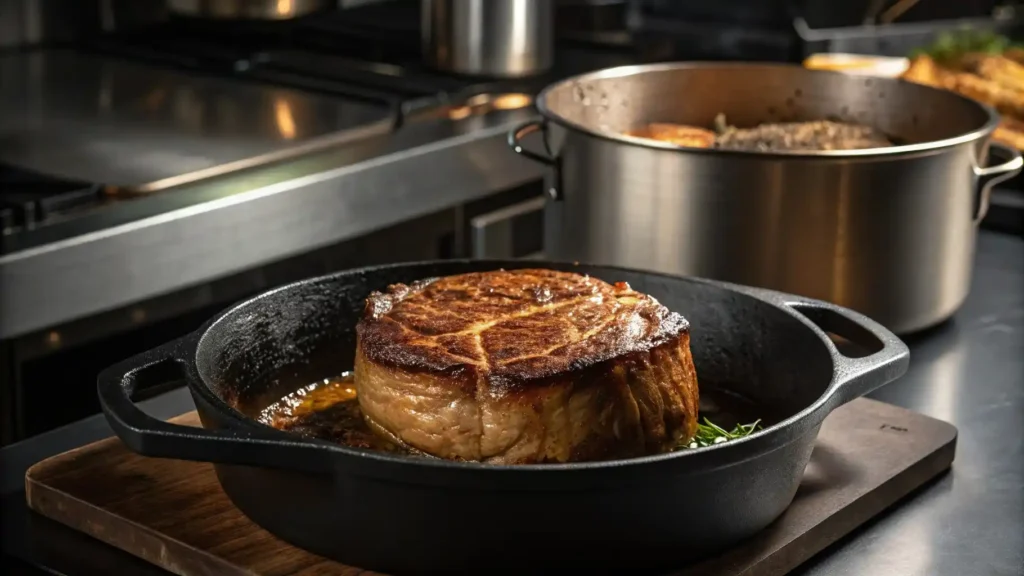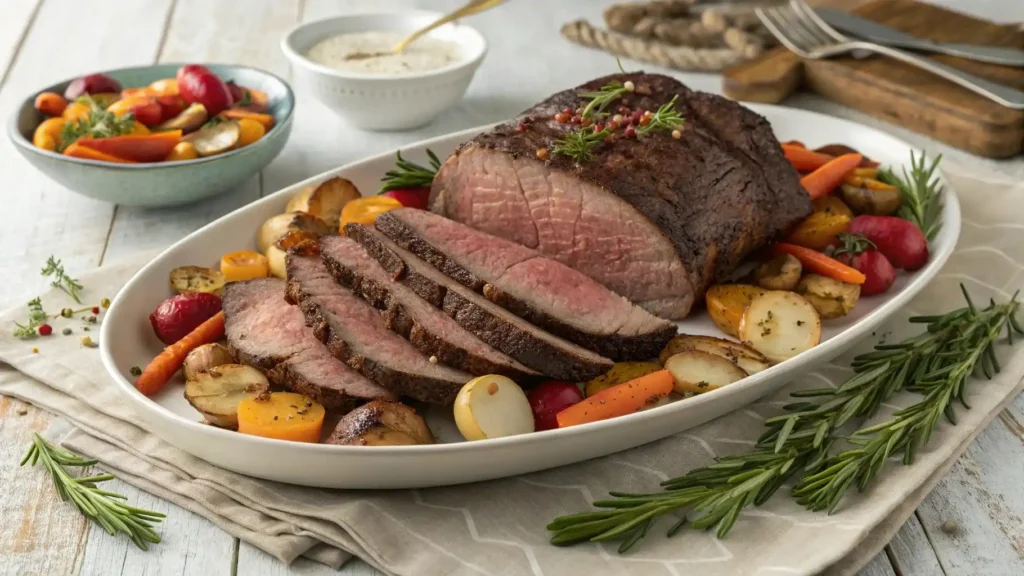Introduction to Beef Pot Roast
What Is Beef Pot Roast?
Beef pot roast is a classic dish that involves slow-cooking a large cut of beef until it becomes tender and flavorful. Typically, the meat is cooked with vegetables, herbs, and liquids like broth or wine, resulting in a hearty and comforting meal. The slow cooking process allows the connective tissues in the beef to break down, making the meat incredibly tender and easy to pull apart.
Why It’s a Classic Comfort Food
This dish is often associated with home-cooked meals and family gatherings. Its rich, savory flavors and tender texture make it a favorite for many. The dish is not only filling but also versatile, allowing for various ingredients and cooking methods. Whether it’s a Sunday dinner or a special occasion, it brings warmth and nostalgia to the table.
Types of Meat for Beef Pot Roast
Best Cuts of Meat for Pot Roast
The best cuts of meat for this dish are those with a good amount of marbling and connective tissue. These cuts include chuck roast, brisket, and round roast. Chuck roast is particularly popular due to its balance of fat and meat, which contributes to a tender and flavorful result.
Choosing the Right Beef for Tenderness and Flavor
When selecting beef, look for cuts that are well-marbled with fat. This fat melts during the cooking process, keeping the meat moist and adding depth to the flavor. Additionally, cuts with more connective tissue, like chuck roast, break down during slow cooking, resulting in a more tender dish.
How to Prepare Beef Pot Roast
Seasoning for Maximum Flavor
Seasoning is crucial for a flavorful roast. A simple mix of salt, pepper, garlic powder, and onion powder can go a long way. For added depth, consider using herbs like rosemary, thyme, and bay leaves. Don’t forget to season the meat generously on all sides before cooking.
Marinating or Not? Understanding the Best Preparation Methods
While marinating can add flavor, it’s not necessary for this dish. The slow cooking process itself infuses the meat with rich flavors from the cooking liquids and vegetables. However, if you prefer marinating, a mixture of olive oil, garlic, and herbs can enhance the taste.
Cooking Techniques for Beef Pot Roast

Slow Cooker: The Easiest Method
Using a slow cooker is one of the easiest methods for making this dish. Simply place the seasoned meat, vegetables, and liquids in the slow cooker and let it cook on low for 8-10 hours. This method requires minimal effort and results in a tender and flavorful roast.
Oven Roasting: A Traditional Approach
Oven roasting is a traditional method that involves cooking the roast in a covered dish at a low temperature (around 300°F) for several hours. This method allows for even cooking and a rich, concentrated flavor.
Stovetop or Dutch Oven: For Rich, Deep Flavors
Cooking on the stovetop using a Dutch oven is another excellent method. The heavy-bottomed pot distributes heat evenly, and the tight-fitting lid traps moisture, resulting in a tender and flavorful dish. This method also allows for easy browning and deglazing, adding depth to the meal.
The Secret to a Tender Beef Pot Roast
The Importance of Low and Slow Cooking
The key to a tender roast is low and slow cooking. Cooking the meat at a low temperature for an extended period allows the connective tissues to break down, resulting in a tender and juicy dish. Rushing the process by cooking at a high temperature can lead to tough and dry meat.
Using Broth, Wine, and Other Liquids for Moisture
Liquids like beef broth, red wine, and even beer are essential for keeping the roast moist during cooking. These liquids also infuse the meat with additional flavors, making the dish more complex and delicious. Make sure to add enough liquid to cover about halfway up the meat.
How Long Should You Cook It for Tenderness?
The cooking time depends on the size of the cut and the cooking method. Generally, a 3-4 pound roast will take about 3-4 hours in the oven or 8-10 hours in a slow cooker on low. The meat should be fork-tender when done, meaning it easily pulls apart with a fork.
Recipes and Variations
Classic Recipe
A classic recipe includes a chuck roast, carrots, potatoes, onions, and celery, cooked with beef broth and seasoned with salt, pepper, and herbs. This timeless recipe is a crowd-pleaser and perfect for any occasion.
With Vegetables and Herbs
Adding a variety of vegetables like parsnips, turnips, and mushrooms can elevate your dish. Fresh herbs like rosemary, thyme, and parsley add a burst of flavor, making it even more aromatic and delicious.
Unique Variations: Adding Spices and Wine
For a unique twist, consider adding spices like smoked paprika, cumin, or coriander. Red wine can also be used as a cooking liquid, adding a rich and complex flavor to the dish.
With Gravy or Sauce: A Rich Addition
Enhance your roast by serving it with a rich gravy or sauce. Simply strain the cooking liquids, thicken with a roux or cornstarch slurry, and season to taste. This adds an extra layer of flavor and richness.
How to Serve Beef Pot Roast

Best Side Dishes to Pair With It
This dish pairs well with a variety of side dishes. Mashed potatoes, roasted vegetables, and crusty bread are classic choices. For a lighter option, consider a fresh green salad or steamed greens.
Serving for Special Occasions
It’s perfect for special occasions like holidays or family gatherings. Serve it as the centerpiece of your meal, accompanied by a selection of sides and a good bottle of red wine. The dish’s rich flavors and comforting nature make it a hit with guests.
Common Mistakes to Avoid
Overcooking vs Undercooking: The Fine Line
Finding the perfect cooking time is crucial for a tender roast. Overcooking can make the meat dry and tough, while undercooking can leave it chewy and hard to pull apart. Use a meat thermometer to ensure the internal temperature reaches at least 145°F for medium-rare, but aim for around 200°F for a tender, pull-apart texture.
Choosing the Wrong Cut of Beef
Not all cuts of beef are suitable for this dish. Lean cuts like sirloin or tenderloin lack the necessary fat and connective tissue, resulting in a dry and tough roast. Stick to cuts like chuck roast, brisket, or round roast for the best results.
Not Using Enough Liquid: Why It’s Important
Using enough liquid is essential for keeping the roast moist and flavorful. The liquid helps to break down the connective tissues and infuse the meat with flavor. Make sure to add enough broth, wine, or water to cover at least halfway up the meat.
Leftover Ideas
Creative Ways to Use Leftovers
Leftovers can be used in a variety of creative ways. Shred the meat and use it in tacos, burritos, or quesadillas. It can also be added to soups, stews, or casseroles for a quick and easy meal.
Sandwiches and Stews
One of the most popular ways to use leftovers is in sandwiches. Simply slice or shred the meat, pile it on a crusty roll, and top with your favorite condiments. Leftovers can also be added to a beef stew for a hearty and comforting dish.
FAQs
What kind of meat is used?
It’s typically made from cuts like chuck roast, brisket, or round roast. These cuts have a good amount of fat and connective tissue, which break down during slow cooking to create a tender and flavorful dish.
What is the secret to a good roast?
The secret is low and slow cooking. Cooking the meat at a low temperature for an extended period allows the connective tissues to break down, resulting in a tender and juicy dish. Searing the meat before cooking and using enough liquid are also crucial steps.
How to cook it?
To cook it, season the meat generously, sear it on all sides, and then slow cook it with vegetables and liquids like broth or wine. Cook in a slow cooker, oven, or Dutch oven until the meat is fork-tender.
What is the difference between pot roast and beef stew?
Pot roast involves cooking a large cut of beef whole, while beef stew involves cutting the beef into smaller pieces and cooking it with vegetables and broth. Both dishes are slow-cooked to achieve tender meat.
Conclusion
Wrapping Up Your Perfect Experience
This dish is a timeless classic that brings comfort and warmth to any meal. By choosing the right cut of meat, seasoning it well, and cooking it low and slow, you can create a tender and flavorful roast that will impress your family and friends.
Why It’s Worth the Effort
While it requires some time and effort, the result is well worth it. The rich, savory flavors and tender texture make it a dish that everyone will love. Whether it’s for a special occasion or a cozy family dinner, it’s sure to be a hit.

